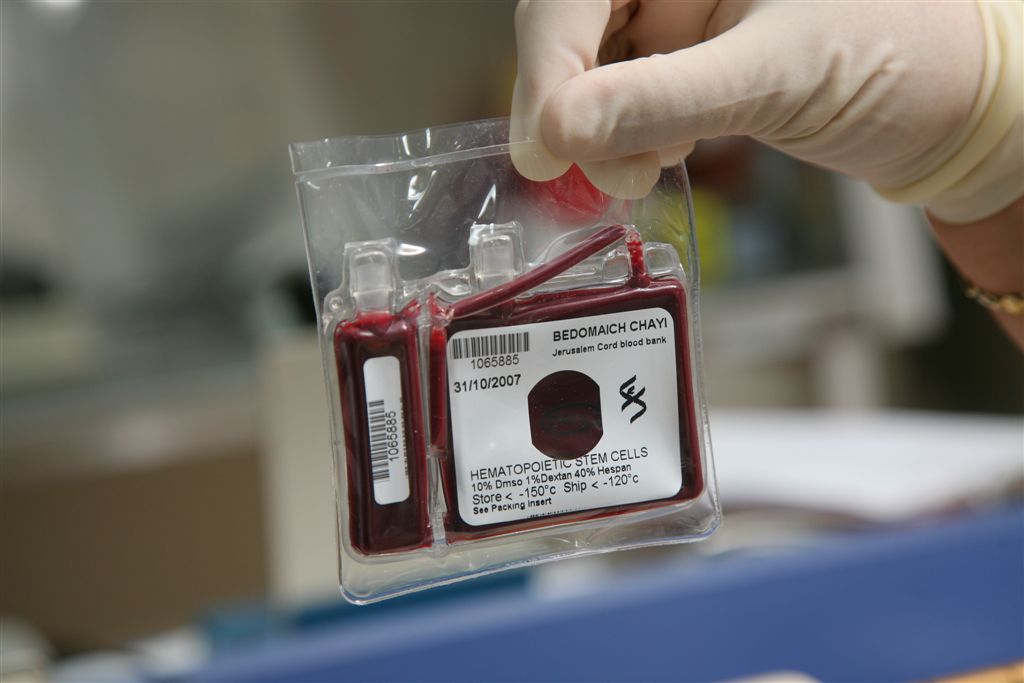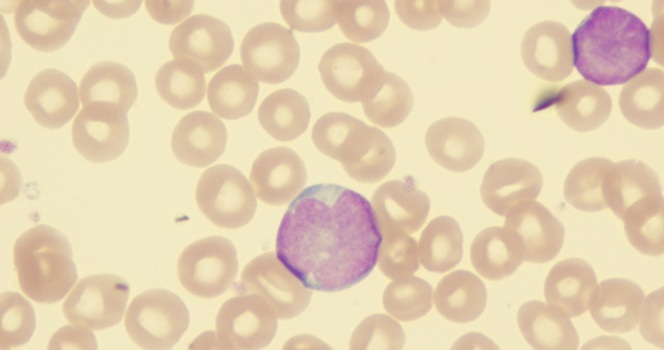Cord Blood Transplants May Outperform Matched Sibling Donors
|
By LabMedica International staff writers Posted on 16 Jun 2020 |

Image: A unit of cord blood that can be used for stem cell transplants (Photo courtesy of Catholic University of Valencia).
When a cancer patient needs a bone marrow transplant, there are four common donor sources: A matched related donor (sibling), a matched unrelated donor (from a donor database), a half-matched donor, or umbilical cord blood.
There are advantages and disadvantages to each approach, but consensus has generally ranked a matched sibling first, followed by a matched unrelated donor, with cord blood and half-matched donors reserved for patients without either of the first two options.
Hematologists at the University of Colorado Anschutz Medical Campus (Aurora, CO, USA) compared outcomes among adult matched related donor (MRD) patients undergoing peripheral blood stem cell transplantation and adult patients undergoing double unit cord blood transplantation (CBT), between 2010 and 2017. A total of 190 CBT patients were compared with 123 MRD patients. Median follow-up was 896 days (range, 169-3,350) among surviving CBT patients and 1,262 days (range, 249-3,327) among surviving MRD patients. For MRD donors, median infused cells were 6.07 × 106 CD34/kg (range, 2.99-9.66).
The scientists reported that in the comparison of 190 patients receiving cord-blood transplants with 123 patients receiving transplants from the "gold standard" of matched sibling donors showed no difference in survival outcomes between these two approaches, with significantly fewer complications due to chronic graft-versus-host disease in patients receiving transplants from cord blood. In addition to showing a decrease in the chance of graft-versus-host disease, which develops when a transplanted blood system attacks a patient's tissues, the study shows a slightly lower rate of relapse in these patients undergoing transplant with cord blood.
Jonathan A. Gutman, MD, CU Cancer Center investigator and director of the allogeneic stem cell transplantation program and senior author of the study, said, “It turns out that for adults, it's very hard to find a single cord blood unit that meets the parameters we know need to be met in terms of size. To overcome this barrier, we often use two units from different sources. We think there are important advantages of cord blood, especially with respect to graft-versus-host disease. Previously, we've taken a position recommending cord blood over matched unrelated donors, and now we show that cord blood may even out-compete the gold standard of matched sibling donors.” The study was published on May 22, 2020 in the journal Blood Advances.
Related Links:
University of Colorado Anschutz Medical Campus
There are advantages and disadvantages to each approach, but consensus has generally ranked a matched sibling first, followed by a matched unrelated donor, with cord blood and half-matched donors reserved for patients without either of the first two options.
Hematologists at the University of Colorado Anschutz Medical Campus (Aurora, CO, USA) compared outcomes among adult matched related donor (MRD) patients undergoing peripheral blood stem cell transplantation and adult patients undergoing double unit cord blood transplantation (CBT), between 2010 and 2017. A total of 190 CBT patients were compared with 123 MRD patients. Median follow-up was 896 days (range, 169-3,350) among surviving CBT patients and 1,262 days (range, 249-3,327) among surviving MRD patients. For MRD donors, median infused cells were 6.07 × 106 CD34/kg (range, 2.99-9.66).
The scientists reported that in the comparison of 190 patients receiving cord-blood transplants with 123 patients receiving transplants from the "gold standard" of matched sibling donors showed no difference in survival outcomes between these two approaches, with significantly fewer complications due to chronic graft-versus-host disease in patients receiving transplants from cord blood. In addition to showing a decrease in the chance of graft-versus-host disease, which develops when a transplanted blood system attacks a patient's tissues, the study shows a slightly lower rate of relapse in these patients undergoing transplant with cord blood.
Jonathan A. Gutman, MD, CU Cancer Center investigator and director of the allogeneic stem cell transplantation program and senior author of the study, said, “It turns out that for adults, it's very hard to find a single cord blood unit that meets the parameters we know need to be met in terms of size. To overcome this barrier, we often use two units from different sources. We think there are important advantages of cord blood, especially with respect to graft-versus-host disease. Previously, we've taken a position recommending cord blood over matched unrelated donors, and now we show that cord blood may even out-compete the gold standard of matched sibling donors.” The study was published on May 22, 2020 in the journal Blood Advances.
Related Links:
University of Colorado Anschutz Medical Campus
Latest Hematology News
- Platelet Activity Blood Test in Middle Age Could Identify Early Alzheimer’s Risk
- Microvesicles Measurement Could Detect Vascular Injury in Sickle Cell Disease Patients
- ADLM’s New Coagulation Testing Guidance to Improve Care for Patients on Blood Thinners
- Viscoelastic Testing Could Improve Treatment of Maternal Hemorrhage
- Pioneering Model Measures Radiation Exposure in Blood for Precise Cancer Treatments
- Platelets Could Improve Early and Minimally Invasive Detection of Cancer
- Portable and Disposable Device Obtains Platelet-Rich Plasma Without Complex Equipment
- Disposable Cartridge-Based Test Delivers Rapid and Accurate CBC Results
- First Point-of-Care Heparin Monitoring Test Provides Results in Under 15 Minutes

- New Scoring System Predicts Risk of Developing Cancer from Common Blood Disorder
- Non-Invasive Prenatal Test for Fetal RhD Status Demonstrates 100% Accuracy
- WBC Count Could Predict Severity of COVID-19 Symptoms
- New Platelet Counting Technology to Help Labs Prevent Diagnosis Errors
- Streamlined Approach to Testing for Heparin-Induced Thrombocytopenia Improves Diagnostic Accuracy
- POC Hemostasis System Could Help Prevent Maternal Deaths
- New Test Assesses Oxygen Delivering Ability of Red Blood Cells by Measuring Their Shape
Channels
Clinical Chemistry
view channel
Chemical Imaging Probe Could Track and Treat Prostate Cancer
Prostate cancer remains a leading cause of illness and death among men, with many patients eventually developing resistance to standard hormone-blocking therapies. These drugs often lose effectiveness... Read more
Mismatch Between Two Common Kidney Function Tests Indicates Serious Health Problems
Creatinine has long been the standard for measuring kidney filtration, while cystatin C — a protein produced by all human cells — has been recommended as a complementary marker because it is influenced... Read moreMolecular Diagnostics
view channel
Simple Urine Test to Revolutionize Bladder Cancer Diagnosis and Treatment
Bladder cancer is one of the most common and deadly urological cancers and is marked by a high rate of recurrence. Diagnosis and follow-up still rely heavily on invasive cystoscopy or urine cytology, which... Read more
Blood Test to Enable Earlier and Simpler Detection of Liver Fibrosis
Persistent liver damage caused by alcohol misuse or viral infections can trigger liver fibrosis, a condition in which healthy tissue is gradually replaced by collagen fibers. Even after successful treatment... Read moreImmunology
view channel
New Test Distinguishes Vaccine-Induced False Positives from Active HIV Infection
Since HIV was identified in 1983, more than 91 million people have contracted the virus, and over 44 million have died from related causes. Today, nearly 40 million individuals worldwide live with HIV-1,... Read more
Gene Signature Test Predicts Response to Key Breast Cancer Treatment
DK4/6 inhibitors paired with hormone therapy have become a cornerstone treatment for advanced HR+/HER2– breast cancer, slowing tumor growth by blocking key proteins that drive cell division.... Read more
Chip Captures Cancer Cells from Blood to Help Select Right Breast Cancer Treatment
Ductal carcinoma in situ (DCIS) accounts for about a quarter of all breast cancer cases and generally carries a good prognosis. This non-invasive form of the disease may or may not become life-threatening.... Read moreMicrobiology
view channel
Rapid Diagnostic Test Matches Gold Standard for Sepsis Detection
Sepsis kills 11 million people worldwide every year and generates massive healthcare costs. In the USA and Europe alone, sepsis accounts for USD 100 billion in annual hospitalization expenses.... Read moreRapid POC Tuberculosis Test Provides Results Within 15 Minutes
Tuberculosis remains one of the world’s deadliest infectious diseases, and reducing new cases depends on identifying individuals with latent infection before it progresses. Current diagnostic tools often... Read more
Rapid Assay Identifies Bloodstream Infection Pathogens Directly from Patient Samples
Bloodstream infections in sepsis progress quickly and demand rapid, precise diagnosis. Current blood-culture methods often take one to five days to identify the pathogen, leaving clinicians to treat blindly... Read morePathology
view channel
Tunable Cell-Sorting Device Holds Potential for Multiple Biomedical Applications
Isolating rare cancer cells from blood is essential for diagnosing metastasis and guiding treatment decisions, but remains technically challenging. Many existing techniques struggle to balance accuracy,... Read moreAI Tool Outperforms Doctors in Spotting Blood Cell Abnormalities
Diagnosing blood disorders depends on recognizing subtle abnormalities in cell size, shape, and structure, yet this process is slow, subjective, and requires years of expert training. Even specialists... Read moreTechnology
view channel
Artificial Intelligence Model Could Accelerate Rare Disease Diagnosis
Identifying which genetic variants actually cause disease remains one of the biggest challenges in genomic medicine. Each person carries tens of thousands of DNA changes, yet only a few meaningfully alter... Read more
AI Saliva Sensor Enables Early Detection of Head and Neck Cancer
Early detection of head and neck cancer remains difficult because the disease produces few or no symptoms in its earliest stages, and lesions often lie deep within the head or neck, where biopsy or endoscopy... Read moreIndustry
view channel
Abbott Acquires Cancer-Screening Company Exact Sciences
Abbott (Abbott Park, IL, USA) has entered into a definitive agreement to acquire Exact Sciences (Madison, WI, USA), enabling it to enter and lead in fast-growing cancer diagnostics segments.... Read more























